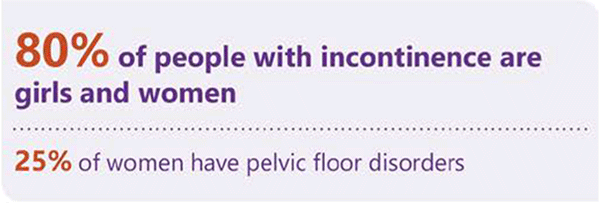, News
The Australian Government’s newly-released National Women’s Health Strategy 2020-2030 identifies incontinence as a key health risk for women and girls.
Whilst there was no reference to incontinence in the National Women’s Health Policy 2010, it is pleasing to see that this important and very common health condition is addressed multiple times in the new 2020-2030 Strategy.
“There was reference to the importance of the National Continence Program in the new Draft Women’s Health Strategy 2020-2030 which was pleasing but it only appeared in the section on Health Ageing,” said Continence Foundation of Australia Former CEO, Rowan Cockerell.
The Foundation’s submission made those drafting the Strategy aware that:
- In 2010, 1.34 million and 296,435 women of reproductive age (15 to 44 years) were living with urinary and faecal incontinence, respectively3.
- 1 in 3 women who have ever had a baby will experience incontinence5. Young women are at high risk of developing incontinence, but it is highly preventable.
- Women and girls with mental health issues are at risk of developing incontinence and urinary incontinence is a predictor for anxiety and depression6,7.
- The economic burden of incontinence totalled $66.7 billion in 2010 and most of the cost of incontinence (74%) is borne personally by individuals, particularly by women3.
The Continence Foundation of Australia is pleased to see incontinence acknowledged in the new National Women’s Health Strategy in the maternal, sexual and reproductive health priority area, as well as priority area two - healthy ageing.
“At least four million women in Australia have their quality of life as well as physical and mental health affected by urinary or faecal incontinence. Finally, women of all ages now have their experiences recognised in the Health Strategy,” said Mrs Cockerell.

From the ‘Women’s health at a glance’ section of the National Women’s Health Strategy
The Strategy aims to address the health issues that affect women and girls throughout their lives and sets specific actions to meet these goals. Actions include establishing specialist primary care services for incontinence, increasing access to services and encouraging use of follow up postnatal care pathways.
A key measure of success for the maternal, sexual and reproductive health priority area is destigmatisation of urinary and faecal incontinence and improved access to care (including pelvic floor physiotherapy).
The National Women’s Health Strategy 2020-2030 is published on the Department of Health’s website.
References
1. Nous Group. Summary of Outcomes – National Men’s Health Forum 2018. [Internet].2018 [cited 2018 December 12]. Available from: https://consultations.health.gov.au/population-health-and-sport-division-1/online-consultation-for-the-national-mens-health-s/supporting_documents/Outcomes%20of%20the%20National%20Mens%20Health%20Forum.PDF
2. Australian Institute of Health and Welfare. Incontinence in Australia. Cat. no. DIS 61. Canberra: AIHW; 2013.
3. Deloitte Access Economics. The economic impact of incontinence in Australia. The Continence Foundation of Australia; 2011.
4. Mohamed AM, Hassouna MS, Kassem MS. Gender differences in factors associated with patients' decisions to seek treatment for urinary incontinence in Alexandria, Egypt. Eastern Mediterranean Health Journal. 2010 Nov 1;16(11):1170-82.
5. Thom DH, Rortveit G. Prevalence of postpartum urinary incontinence: a systematic review. Acta obstetricia et gynecologica Scandinavica. 2010 Dec 1;89(12):1511-22.
6. Chiarelli P, Brown W, McElduff P. Leaking urine: prevalence and associated factors in Australian women. Neurourology and urodynamics. 1999;18(6):567-77.
7. Felde G, Ebbesen MH, Hunskaar S. Anxiety and depression associated with urinary incontinence. A 10‐year follow‐up study from the Norwegian HUNT study (EPINCONT). Neurourology and urodynamics. 2017 Feb;36(2):322-8.

